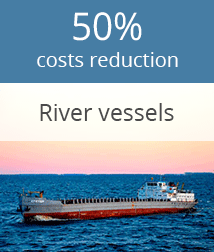
Ship fuel monitoring with DFM flow meters
It is common knowledge that numerous vessels still lack accurate systems for monitoring their fuel consumption. This is a critical matter since fuel expenditures represent 45-60% of a vessel’s operational costs.
We are certain that no shipowner would decline the chance to decrease these costs by 10%, or even 50%. This objective can be accomplished by installing a fuel monitoring system based on direct fuel measurement devices – DFM fuel flow meters within the fuel system.
The main improvement points, where DFM fuel flow meters can help to save operating costs::
1. Detection of fuel theft, misuses and fuel leakage.
2. Accurate recording of fuel usage by each consumer on the vessel.
3. Monitoring fuel system health and operating hours and improving maintenance schedule.

The basis of comprehensive fuel-saving system – DFM fuel flow meters.
DFM fuel flow meters are direct measurement tools installed in the fuel lines of various diesel engines. Installing DFM flow meters is a cost-effective way to implement fuel-saving methods across various types of vessels – from fishing boats to barges and ferries.
To communicate between each other and with external devices e.g. telematics units or NMEA-displays, DFM flow meters utilize wired S6 interface (including NMEA 2000) and wireless S7 (Bluetooth) interface. Measurement ranges from 0.5 to 8,000 liters allows ship owners to monitor all fuel consumers on board, including engines, diesel generators, and boilers.
Flowmeters of DFM Marine series have extra protection against corrosion and certified with NMEA for installation on sea and river vessels.
Getting fuel consumption data from DFM flow meters

Once installed in the fuel line, the flow meters are immediately ready for use. DFM flow meters can show measurement results on an integrated display or send it via the Internet.
- When you connect flow meters to CANUp telematics gateway, you gain access to a new level of control – dozens of key performance indicators of your vessel become available online in the telematics service. You can remotely receive information about the operation of the ship’s systems and generate convenient reports.
- If DFM is equipped with embedded dispaly or has Blutooth connectivity – the data is available offline. Ship crew can monitor fuel usage on DFM’s display or using smarthpone app.
Parameters recorded by the DFM fuel flow meters
Fuel consumption
- Instant fuel consumption, L/H
- Hourly fuel consumption in “Forward” line
- Hourly fuel consumption in “Return” line
- Total fuel consumption, L
- Total fuel consumption in “Idling” mode of engine operation
- Total fuel consumption in “Optimal” mode of engine operation
- Total fuel consumption in “Overload” mode of engine operation
- Total fuel consumption in “Negative” mode of flow meter operation (return exceeds supply)
Engine operating time
- Total operating time, h
- Total operating time in each of “Idling” / “Optimal” / “Overload” engine operation modes
- Operating time in “Tampering” or/and “Interference” mode, h
Special
- Current engine operation mode as per fuel consumption rate
- Fuel temperature
- Battery charge
How to get the most use out of DFM fuel flow meter data
Accurate measurement of fuel consumption allows optimizing engine performance and prevent fuel theft. Predicting fuel system wear becomes simpler with precise information about fuel consumption, time, and operational modes. Using this data, you can precisely determine economical operation modes and CO2 emissions. This ultimately helps achieve the primary objective – reducing fuel consumption and decreasing CO2 emissions.
In addition to substantial fuel savings, when DFM fuel flow meter becomes a part of a telematics solutions for ship, it enables you to remotely monitor other vessel parameters: engines operating time and operating modes, fuel temperature, and correlate that information to ship movement data.
In addition to substantial fuel savings, telematics solutions for water transport enable you to remotely monitor other parameters: engine operating time and operating modes, fuel volume in tanks, engine temperature, and any telemetry. Effective management is always based on control, and Technoton’s telematics solutions effectively address this issue.
Technoton has been developing, manufacturing, and installing telematics systems for over 20 years. Thousands of the company’s clients worldwide have implemented precise accounting, fuel savings, and are confident that the payback period for equipment ranges from 1 to 5 months.
Usage cases
Transportation company
Task: fuel consumption monitoring of river vessels and optimization of routes.
Solution: DFM 250CCAN fuel flow meters, DFM 100CCAN fuel flow meters, GPS-trackers.

Large logistics companies
Task: fuel consumption monitoring of sea vessels, composition of efficient fleet monitoring system for multimodal transportation.
Solution: DFM Marine, DFM 250CCAN and DFM 100CCAN fuel flow meters. Data can be sent to telematics service and dashboard.
Result: operation costs reduction up to 40%




